Bandhani Printing
Bandhani Prints is a type of tie and dye that is made by plucking the cloth with the fingernails into many tiny bindings that form a figurative design. The term Bandhani is derived from Sanskrit/Hindi word “Bandhana” (to tie). Today Bandhani Prints are practiced in Gujarat, Rajasthan which is also famous for wooden printing blocks and Block printing on fabric as well as the states of Sindh, Punjab, parts of UP, and Tamil Nadu where it is known as Sangndi.
The History Of Bandhani Prints
Bandhani also known as Bandhej, is the oldest form of the Tie and Dye technique. The origin of Bandhani Prints dates back to Indus Valley Civilization where dyeing was done as early as 4000 BC. The earliest forms of Bandhani were found in the wall of Ajanta caves where the first Bandhani printed saree was worn at the royal wedding and this ancient art is still practiced.
The vivid colors of Rajasthan, folk dancers dancing in their bright bandhani-printed ghagra, and majestic bandhani-printed turbans are the kind of images that come to our mind with the word “Bandhani”.
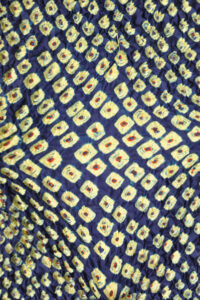
How do we make Bandhani Prints?
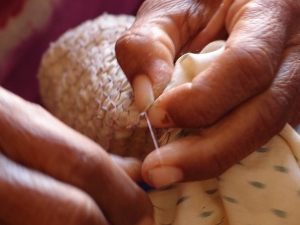
The art of making Bandhani Prints is a highly skilled process. This tie and dye technique involves two steps:
- Tying a part of the fabric: The fabric to be dyed is tied very tightly at different points, forming a pattern or prints. These prints can be made from a few to hundreds to thousands of images before dipping them in a shade of color.
- Dyeing- Coloring the fabric into different shades: The process of dipping the tied fabric into different shades of color is called dyeing. The tied part of the fabric does not catch color and remains the same color as the fabric.
Once the fabric is dyed it is kept in the sun for a few hours. Bandhani Prints are a result of a lot of designs like little squares, dots, and rings. These designs mostly depict the tradition of Rajasthan and Gujrat.
The tie and fabric colors of Bandhani are particularly found in Gujarat and Kutch. On the other hand, Rajasthan boasts of the finest craftsmanship of Bandhani prints. The Leheriya print is very famous and originates from Rajasthan. The craftsmen from Rajasthan lift the fabric for tying with their long nails or a sharp object on their ring. The Gujarati karigars work without these supports as the work gets better when the work is carried out with one’s bare hands to prevent any damage to the fabric.
The Colors of Bandhani Prints
In the ancient era, tree and leaf extracts were used for coloring the fabric. Of late, chemical dyes have replaced those extracts and are now used in making prints. Each color has its own significance.
Bandhani being such a vivacious craft finds itself deeply connected to auspiciousness. It makes use of dark, deep tones, but usually begins with lighter hues.
RED, which is a symbol of marriage, is believed to give a good future and fortune to a newlywed bride.
SAFFRON is the color of a yogi.
YELLOW symbolizes spring and joy.
BLACK AND MAROON are the colors of mourning.
Nowadays other shades like purple, beige, pink ochre, and indigo are used.
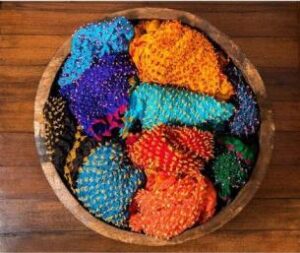
The Patterns of Bandhani Prints
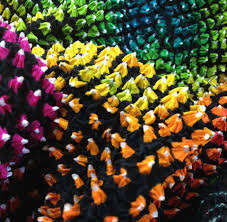
A single Bandhani is called Ek Dali or Bundi, four dots are called Chaubandi, and seven are called Satbundi. Small dots with darker centers are referred to as Boond while tar-drop-shaped dots are known as Kodi. The cluster design that we see is called Trikunti, while groups of four are called Chaubasi, and seven forms the Satbandi.
There can be several elaborate designs created by repeating Bandhani dots and patterns. They include leaves, flowers, trees, and even human figurines. Dungar Shahi (mountain pattern), Laddu Jalebi (Indian sweetmeats), and Leheriya (waves) are other commonly known Bandhani patterns.
The Contemporary Bandhani Prints
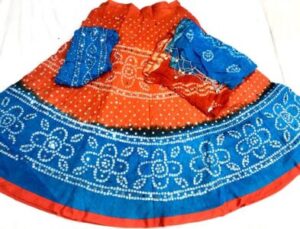
Popularity of Bandhani
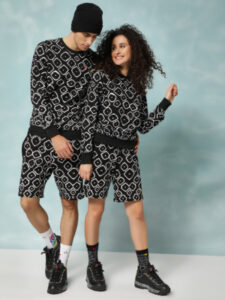
The popularity of Bandhani is not just confined to India but has expanded all over the globe in the recent past. The popularity especially soars during the festive and wedding season. The Bandhani print is embellished with mirror work or go-to-work to give it a majestic look.
Traditional Bandhani designs have Indian as well as global appeal to them. Bandhani can also be printed on the fabric and can be given a classic appeal. Dresses made out of Bandhani are also a great craze among people of all generations. Bandhani motifs also found a huge space in the men’s fashion market. Bandhani motifs were seen as prints on turbans and even on pockets of kurtas, to add a traditional look.
The Bandhani Printed Sarees
While Bandhani prints are popularly used for making suits, dupattas, cholis, bags, etc, Bandhani Printed sarees remain the most popular ensemble of Bandhani Prints. They are regarded as the most auspicious gifts to be gifted at the daughter’s wedding.
There are different types of Bandhani printed saree:
1. Jhankar Bandhani Printed Saree: This type of Bandhani Printed sarees is very colorful and vibrant, and has extremely fine patterns. Jhankaar Bandhani doesn’t have light or white-colored dots, like other Bandhani styles. For example, an all-green Jhankaar Bandhani will have red or maroon dots.
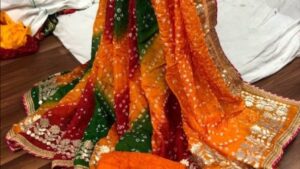
2. Borjaal Bandhani Printed Saree: Used mostly for Wedding occasions, this type of Bandhani printed saree is highly intricate and has full jal work of Bandhani all over. It is extremely popular in Marwari communities. Borjaal Bandhani Sarees have a very intricate and striking interplay of colors, patterns, and dots, that together create an amazing maze design on the fabric. They are available in many colors and can be made on georgettes too.
3. Banarasi Bandhani Printed Saree: Another innovation of the Bandhej saree is the Banarasi Bandhani saree which is an essential, Bandhani saree with a Banarasi brocade border. It is generally made using pure, high-quality georgette fabric that is adorned with brocade and Banarasi weave borders. Bandhani done on these expensive sarees is often extremely fine and included in the traditional bridal trousseau.
Bandhani Printed fabric is delicate and needs to be stored and maintained carefully. Dry cleaning is the best way to take care of it and it must be stored properly so that it doesn’t lose its color or tensile strength. Bandhani has been here for centuries and is here to stay for many years to come. Variations of Bandhani fabric will increase and will continue to flourish. Many skilled craftsmen have been working on this beautiful art for several years now. This art of tie and dye is becoming a huge trend and it has found its valuable space in different accessories and garments.
